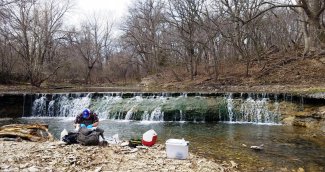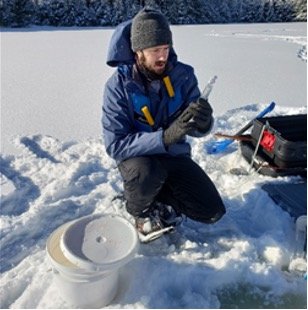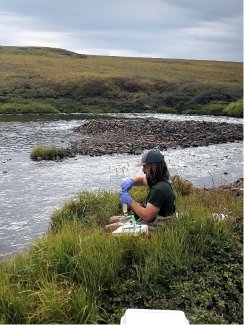Aquatic Microbes
The type and abundance of microbes found in freshwater ecosystems are heavily dependent on factors such as water chemistry, nutrient runoff from surrounding land, temperature, abundance of organic matter, pH, oxygen concentration, light, and water movement. Microbial community composition can vary widely between various habitats within the same lake or stream, resulting in different communities at different depths or with differing benthic substrate characteristics (e.g., sandy, rocky, or muddy). While there are microbes that can live in nearly any aquatic environment, including anaerobic environments or places with temperature extremes, the specific microbes present and their overall and comparative abundance will be heavily influenced by local conditions.
Microbial communities are highly responsive to changes in their environment; they reproduce rapidly under favorable conditions and die off quickly in less favorable conditions. These changes may be seasonal or due to extreme weather events, such as storms that result in higher-than-usual levels of nutrient or chemical runoff from surrounding land, land use changes, or other environmental disruptions. As microbial communities change in response to changing environmental conditions, this will also impact the algal, plant, and animal species that depend on them either directly or for their role in cycling nutrients in the ecosystem. Monitoring changes in aquatic microbial communities provides a window into the overall health of the aquatic system.
At NEON aquatic field sites, aquatic microbes—including bacterial, fungal, and archaeal species—are collected from surface water and from the benthos (sediment-water interface). Microbes mediate nutrient cycling in all habitats. Temperature, nutrient and carbon availability, physical dispersal in flowing water, and competition all control microbial community composition and activity. Because of these factors, aquatic microbe samples are collected concurrently with surface water chemistry and benthic algae samples. Collecting basic measures of biomass, enzymatic activity, and DNA will enable researchers to assess changes in this key ecosystem group of organisms and provide important insights into the overall health and productivity of the aquatic ecosystem.

Field technicians preparing for benthic sampling at McDiffett Creek (MCDI)
Sampling Design and Methods
Aquatic Microbe Sample Collection
Aquatic microbe samples are collected at all 34 aquatic sites, including 24 wadeable streams, seven lakes, and three non-wadeable rivers. Aquatic microbe samples are collected using field sterile methods to preserve in situ diversity and minimize cross contamination. Collection techniques are standardized and based closely on the existing national-scale sampling efforts.
Surface Water Sampling

NEON field ecologist samples surface water for microbes during winter at D05 CRAM (Photo by Hannah Beeler)
Surface water samples are collected 12 times per year at stream locations and six times per year at lake and river locations. They are collected at the same time, location, and sampling depth as water chemistry samples, and taken at a single location for river and stream sites, near the sensor infrastructure. In lakes, samples are collected near the buoy. In lakes with true inlets and outlets, samples are also collected near the littoral (or nearshore) infrastructure during the ice-free portion of the year. Stream samples are collected year-round, including times when the surface is frozen, as long as the ice can be broken by hand. Sampling is suspended if the ice is too thick. At northern lake and river sites, samples are collected year-round and under ice during the winter months.
Surface water field samples are collected as grab samples in the water column of the stream, lake, or river in conjunction with surface water chemistry samples. Samples are collected using a grab sampler, typically a sterilized 4-liter jug in streams and a grab sampler (Kemmerer or Van Dorn) in lakes or rivers. In lakes and rivers with stratification (different thermal layers), samples are collected separately at various depths. For streams and non-stratified rivers and lakes, a single sample of water is collected near the surface, at 0.5 m depth (lakes/rivers), or in the thalweg (line of lowest elevation within the waterway) of wadable streams. In stratified rivers and lakes, a second sample is taken from the midpoint of the hypolimnion (the dense, cool bottom layer of a stratified body of water). For deeper waters (with a hypolimnion layer >4 m deep), two integrated samples are taken at different depths in the hypolimnion layer. Water column samples for microbial analysis may be collected either immediately before or after water chemistry samples, as long as the water column remains undisturbed. Sample water is filtered, flash-frozen in the field, then shipped to an external facility for DNA extraction and sequencing. DNA extracts and whole filtered samples are stored at the NEON Biorepository.

A NEON field ecologist collects benthic microbes from a rock scrub at D18 OKSR (Photo by Josh Monroe)
Benthic Microbe Sampling
Benthic microbe samples are collected only from wadeable stream sites. They are collected both as whole samples (plant or sediment grab) and on filters at the same times and location as periphyton (microalgae) field sampling, in two different habitat types within the stream reach. Samples are collected at each location using the most appropriate sampler for the specific habitat and substratum characteristics. Sampling methods may include grab sampling of sediment or plants and rock or woody debris scrubs. Periphyton samples (organisms found on the surface of plants and other objects projecting above the sediment surface) are collected in the two most dominant benthic habitat types (e.g. riffles, runs, pools, step pools) at each NEON stream site.
Benthic microbe samples are collected three times per year in wadeable streams at the same time and location as algal periphyton samples. They are collected during periods of stable stream flow, when the stream is not flooding and has not flooded within the past 14 days. Sampling is conducted during the spring, summer, and autumn seasons within a 30-day sampling window specified for each season and location. The sample schedule for each site is determined based on historical data including ice on/ice off, streamflow, accumulation of degree days, riparian greenness. In some cases, such as late ice-off in the spring, sampling may be conducted outside of the sample window, but there must be a minimum of two weeks between sample dates. Benthic samples are collected at up to eight locations within a 1-km reach of the stream, which extends both upstream and downstream of the sensor set and surface microbe sampling location. Samples are collected in two different habitats on each sampling day (e.g., riffles, runs, or pools).
Cell count samples are preserved in the field and chilled, while samples destined for DNA sequencing are filtered and flash-frozen on dry ice and shipped to an external lab for analysis. Scrub samples are filtered and flash-frozen in the field. Grab samples are flash frozen in the field. All samples are sent to an external facility for DNA extraction and sequencing. DNA extracts and whole filtered samples are stored at the NEON Biorepository.
Processing and Lab Analysis
Upon arrival at the external analytical facility, samples are further prepared for laboratory analysis. Surface water cell counts are conducted using propidium iodide (PI) staining and epifluorescence microscopy. Image analysis software is used to enumerate the cells, resulting in abundance data. DNA is extracted from filtered water and grab samples. High-throughput sequence analysis using primer sets targeting the 16S and ITS-1 regions of the ribosomal RNA gene for bacterial, archaeal, and fungal characterization. Quality-filtered sequence data are processed bioinformatically, generating taxon tables. Laboratory data are passed through the NEON automated ingest process for basic QC testing and acceptance and then are published on the NEON data portal. Raw sequence data are can be accessed through the NEON data portal.
Data Products
Samples for chemical analysis of surface water are collected concurrently with surface water microbial samples. Surface water aquatic microbe data includes:
- Surface Water Microbe Cell Count (DP1.20138.001)
- Surface Water Microbe Community Composition (DP1.20141.001)
- Surface Water Microbe Group Abundances (DP1.20278.001)
- Surface Water Microbe Marker Gene Sequences (DP1.20282.001)
- Surface Water Microbe Metagenome Sequences (DP1.20281.001)
Benthic samples are collected concurrently with periphyton samples at wadeable stream locations. Benthic microbe data includes:
- Benthic Microbe Community Composition (DP1.20086.001)
- Benthic Microbe Group Abundances (DP1.20277.001)
- Benthic Microbe Marker Gene Sequences (DP1.20280.001)
- Benthic Microbe Metagenome Sequences (DP1.20279.001)
Archival Samples
Archival samples of water and sediment collected at NEON aquatic field sites are available from the NEON Biorepository.
| Types of Samples | Storage Condition | Storage Container | Quantity Archived (Annually) † | Link to the Collection |
|---|---|---|---|---|
| Aquatic microbial samples, benthic | -80 °C | Sterivex filters | 360 to 440 samples | Benthic Microbe Collection (Sterivex Filters) (NEON-BEMC-SF) |
| DNA extracts from benthic samples | -80 °C | 96-well plates‡ | 600 to 800 extracts | Benthic Microbe Collection (DNA Extracts) (NEON-BEMC-DNA) |
| Aquatic microbial samples, surface water | -80 °C | Sterivex filters | 300 to 400 samples | Surface Water Microbe Collection (Sterivex Filters) (NEON-SWMC-SF) |
| DNA extracts from surface water collection | -80 °C | 96-well plates‡ | 250 to 400 samples | Surface Water Microbe Collection (DNA Extracts) (NEON-SWMC-DNA) |
† Quantities represented in this table are annual quantities expected from sampling conducted throughout the observatory during full Operations. Actual quantities may differ from these projections
‡ Quantities are number of samples (not number of well plates); up to 96 samples are contained on the same well plate